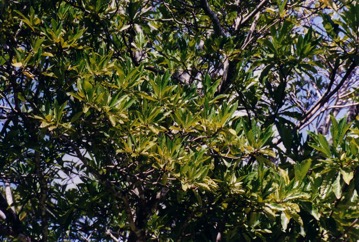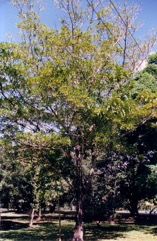Genipa

A tropical plant. It grows in the hot tropical lowlands. It is native to tropical America. It grows in rainfall of 1,500-4,500 mm per year. The temperatures are 22-30°C. It is common in swamp marshes. In Central America it grows from sea level to 1,000 m altitude. In Argentina it grows below 500 m above sea level.
Also known as:
Bi, Bii, Bilito, Bitu, Caruto, Crayo, Danipa, Genip, Genipapo, Genipayer, Genipe, Huito, Huitu, Iluale, Jagua, Jagua azul, Jagua blanca, Janipaba, Janipapeiro, Janipapo, Jenipapeiro, Jenipapinho, Jenipapo, Jinpa, Maluco, Marmalade box, Nanapabeiro, Nandipa, Nane, Ndia, Shagua, Tejoroso, Tejoruco, Wito, Xagua, Xahua, Yagua, Yaguare, Yoale, Yuale
Synonyms
- Gardenia brasiliensis Spreng.
- Gardenia genipa Sw.
- Genipa excelsa Krause
- Genipa oblongifolia R & P.
- Genipa americana var. caruto (Kunth) Schumach.
- Genipa caruto Kunth
- Genipa condonocalyx Standl.
- Genipa venosa Standl.
- Genipa pubescens DC.
- and others
Edible Portion
- Fruit
Where does Genipa grow?
Found in: Amazon, Antilles, Argentina, Asia, Australia, Barbados, Belize, Bolivia, Brazil, Caribbean, Central America, China, Colombia, Costa Rica, Cuba, Dominican Republic, East Africa, Ecuador, El Salvador, French Guiana, Grenada, Guadeloupe, Guatemala, Guianas, Guyana, Haiti, Hispaniola, Honduras, Indonesia, Malaysia, Mexico, Martinique, Mexico, Mozambique, Nicaragua, North America, Pacific, Panama, Paraguay, Peru, Philippines, Puerto Rico, SE Asia, South America, St. Lucia, St. Vincent and Grenadines, Suriname, Trinidad, Venezuela, Virgin Islands, West Indies
Notes: There are 7 Genipa species. The fruit sap blackens the skin. It has antioxidant properties.
Growing Genipa
Cultivation: Plants are grown from seed. They can also be grown from large cuttings or by grafting. For seed the ripe fruit are harvested and the seeds removed and washed under running water. They are dried in the shade. Seeds only remain viable for 4 months. Seeds germinate in 25-45 days. Seedlings can be transplanted into the field after 7-9 months.
Edible Uses: Fruit are eaten fresh. They need to be over-ripe. They are acid so are more often used for preserves. They can be made into marmalade or drinks. The fruit are fermented to make an alcoholic drink. Caution: Alcohol is a cause of cancer.
Production: Plants grow at a moderate rate. They can be 2 m high in 2 years. A fruit is 200-400 g weight. The fruit is often harvested before it is completely mature then stored in the dark until it is ripe.
Nutrition Info
per 100g edible portion| Edible Part | Energy (kcal) | Protein (g) | Iron (mg) | Vitamin A (ug) | Vitamin c (mg) | Zinc (mg) | % Water |
|---|---|---|---|---|---|---|---|
| Fruit | 113 | 5.2 | 3.6 | - | - | - | 67.6 |
| Fruit | 71 | 0.8 | 0.6 | - | 8.9 | 1.9 | 80.1 |
Genipa Photos


References
Bailao, E. F. L. C., et al, 2015, Bioactive Compounds Found in Brazilian Cerrado Fruits. International Journal of Molecular Sciences. 16:23760-23783
Barwick, M., 2004, Tropical and Subtropical Trees. A Worldwide Encyclopedic Guide. Thames and Hudson p 195
Bortolotto, I. M., et al, 2015, Knowledge and use of wild edible plants in rural communities along Paraguay River, Pantanal, Brazil. Journal or Ethnobiology and Ethnomedicine. 11:46
Bortolotto, I. M., et al, 2018, Lista preliminar das plantas alimenticias nativas de Mato Grosso do Sul, Brasil. Iheringia, Serie Botanica, Porto Alegre, 73 (supl.):101-116
Brazil: Biodiversity for Food and Nutrition. http://www.b4fn.org/countries/brazil/
Chizmar Fernandez, C., et al, 2009, Plantas comestibles de Centroamerica. Instituto de Biodiversidad, Costa Rica. p 271
Condit, R., et al, 2011, Trees of Panama and Costa Rica. Princeton Field Guides. p 392
Coronel, R.E., 1982, Fruit Collections in the Philippines. IBPGR Newsletter p 7
Daly, D. C., An Index of Common Names of Plants in Acre, Brazil. New York Botanical Garden Universidade Federal do Acre.
Etkin, N. L. (Ed.), 1994, Eating on the Wild Side, Univ. of Arizona. p 138 (Also as Genipa caruto), 158
Facciola, S., 1998, Cornucopia 2: a Source Book of Edible Plants. Kampong Publications, p 212
Gonzalez-Espinosa, M. et al, 2011, The Red List of Mexican Cloud Forest Trees. Flora and Fauna International, Cambridge. p 116
Grandtner, M. M., 2008, World Dictionary of Trees. Wood and Forest Science Department. Laval University, Quebec, Qc Canada. (Internet database http://www.wdt.qc.ca)
Grandtner, M. M. & Chevrette, J., 2013, Dictionary of Trees, Volume 2: South America: Nomenclature, Taxonomy and Ecology. Academic Press p 262
Hedrick, U.P., 1919, (Ed.), Sturtevant's edible plants of the world. p 327. p 325 (Also as Gardenia brasiliensis)
Hermandez Bermejo, J.E., and Leon, J. (Eds.), 1994, Neglected Crops. 1492 from a different perspective. FAO Plant Production and Protection Series No 26. FAO, Rome. p17
Hunter, D., et al, 2019, The potential of neglected and underutilized species for improving diets and nutrition. Planta (2019) 250:709-729
Johnson, M. and Colquhoun, A., 1996, Preliminary Ethnobotanical Survey of Kurupukari: An Amerindian Settlement of Central Guyana. Economic Botany, Vol. 50, No. 2, pp. 182-194
Kermath, B. M., et al, 2014, Food Plants in the Americas: A survey of the domesticated, cultivated and wild plants used for Human food in North, Central and South America and the Caribbean. On line draft. p 382 (As Gardenia brasiliensis)
Lorenzi, H., 2002, Brazilian Trees. A Guide to the Identification and Cultivation of Brazilian Native Trees. Vol. 01 Nova Odessa, SP, Instituto Plantarum p 318
Lorenzi, H., Bacher, L., Lacerda, M. & Sartori, S., 2006, Brazilian Fruits & Cultivated Exotics. Sao Paulo, Instituto Plantarum de Estuados da Flora Ltda. p 287
Macmillan, H.F. (Revised Barlow, H.S., et al) 1991, Tropical Planting and Gardening. Sixth edition. Malayan Nature Society. Kuala Lumpur. p 301
Martin, F. W., et al, 1987, Perennial Edible Fruits of the Tropics. USDA Handbook 642 p 55
McLaughlin, J., Woody and Herbaceus Plants Native to Haiti. University of Florida. p 17
Miguel, E., et al, 1989, A checklist of the cultivated plants of Cuba. Kulturpflanze 37. 1989, 211-357
Morton, Julia F., 1987, Fruits of Warm Climates. Creative Resources Systems, Inc. . p. 441
NYBG herbarium "edible"
Paz, F. S., et al, 2021, Edible Fruit Plant Species in the Amazon Forest Rely Mostly on Bees and Beetles as Pollinators. Journal of Economic Entomology, XX(XX), 2021, 1–13
Philips, O., 1992, The potential for harvesting fruits in tropical rainforests: new data from Amazonian Peru. Biodiversity and Conservation 2, 18-38
Plants of Haiti Smithsonian Institute http://botany.si.edu/antilles/West Indies
PROSEA (Plant Resources of South East Asia) handbook, Volume 2, 1991, Edible fruits and nuts.
Russell, T., Cutler, C., & Walters, M., 2005, The Illustrated Encyclopedia of Trees of the Americas. Lorenz Books. p 246
Segura, S., et al, 2018, The edible fruit species in Mexico. Genet Resour Crop Evol (2018) 65:1767–1793
Smith, N., Mori, S.A., et al, 2004, Flowering Plants of the Neotropics. Princeton. p 332, Plate 42 (Photo)
Smith, N., et al, 2007, Amazon River Fruits. Flavors for Conservation. Missouri Botanical Gardens Press. p 222
Sukarya, D. G., (Ed.) 2013, 3,500 Plant Species of the Botanic Gardens of Indonesia. LIPI p 304
Syst. nat. ed. 10, 2:931. 1759
Timyan, J., 1996, Bwa Yo: Important Trees of Haiti. SE Consortium for International Development. Washington. p 214
USDA, ARS, National Genetic Resources Program. Germplasm Resources Information Network - (GRIN). [Online Database] National Germplasm Resources Laboratory, Beltsville, Maryland. Available: www.ars-grin.gov/cgi-bin/npgs/html/econ.pl (10 April 2000)
Vael, L., 2015, Ethnobotanical study of the plant use in the natural landscape of two mestizo communities in the Ucayali region of the Peruvian Amazon. Universiteit Gent.
van Roosmalen, M.G.M., 1985, Fruits of the Guianan Flora. Utrecht Univ. & Wageningen Univ. p 379
Vasquez, R. and Gentry, A. H., 1989, Use and Misuse of Forest-harvested Fruits in the Iquitos Area. Conservation Biology 3(4): 350f
Vasquez, Roberto Ch. & Coimbra, German S., 1996, Frutas Silvestres Comestibles de Santa Cruz. p 202
Villachica, H., (Ed.), 1996, Frutales Y hortalizas promisorios de la Amazonia. FAO, Lima. p 153
World Checklist of Useful Plant Species 2020. Royal Botanic Gardens, Kew
www.colecionandofrutas.org
www.worldagroforestrycentre.org/treedb/
Yuncker, T.G., 1940, Flora of the Aguan Valley and the coastal regions near La Ceiba, Honduras. Botany Series, Field Museum of Natural History 9(4) p 338 (As Genipa caruto)
Zambrana, P, et al, 2017, Traditional knowledge hiding in plain sight – twenty-first century ethnobotany of the Chácobo in Beni, Bolivia. Journal of Ethnobiology and Ethnomedicine (2017) 13:57
Zuchowski W., 2007, Tropical Plants of Costa Rica. A Zona Tropical Publication, Comstock Publishing. p 198